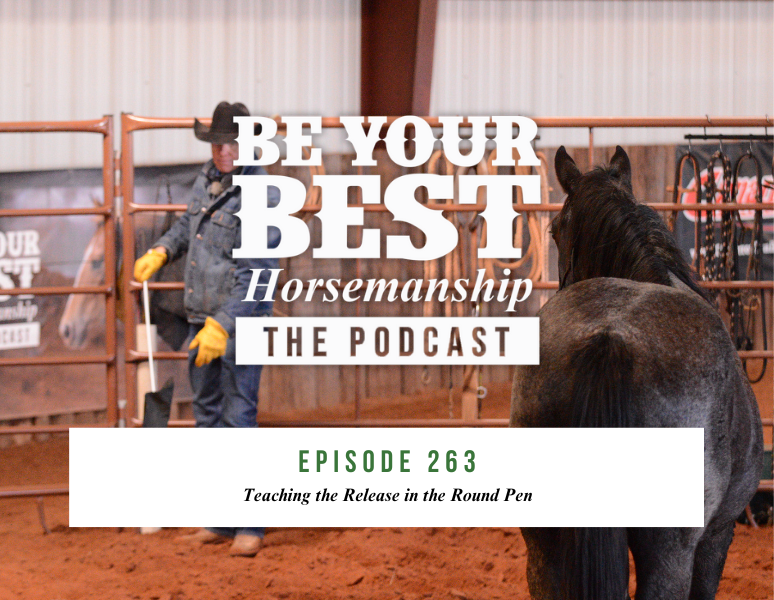Ep 263: Teaching the Release in the Round Pen
We’re kicking off our second week of colt starting mentorships today, and I couldn’t be more excited. Last week was fantastic, and I’m looking forward to seeing how this week unfolds. We’ve got a great group of trainers here again, including Adam Cadez-Schmidt, Ken Peterson, Shane Eliason, and Nate Horner, with Brody McAbee, my assistant, helping out as well. It’s always a great experience when you bring together such a talented group of people, and the horses we’re working with are really showing us what they’ve got.
We’re working with a variety of horses this week—some weanlings, yearlings, and even a couple of two-year-olds. These are horses I bought this fall specifically for these mentorships, and they’ve mostly just been on free-choice alfalfa and allowed to run wild. They’ve got energy to burn, which makes them excellent demonstration horses, but they also challenge us to make a real connection. When horses are fresh, anxious, or insecure, their flight response is in full gear, and that’s when we have to step up our game and help them find that mental switch back to the thinking side of their brain.
During the first week, we started the mentorship with some two-year-olds who hadn’t been worked with much. On the first day, I demonstrated on one of these horses and we put the first ride on him. He’s a big, strong colt—if you don’t approach him the right way, you could end up in a heap somewhere. But we didn’t rush. We took our time, gained his trust, and worked through his anxiety to help him feel confident. It was a great learning experience for everyone involved.
What becomes more apparent the longer you work with horses is that they just want to feel safe and secure. They want to be able to use the thinking side of their brain rather than be stuck in flight mode, reacting to every little thing. It’s something we all can relate to—our minds can only hold one thought at a time, and it’s the same for horses. They’re either thinking or reacting, and you can see it in their body language. The key is to help them switch back to thinking.
That’s where the foundation comes in. The more control we have over that switch, the better off both us and the horse will be. In today’s competitive world of performance horses, we’re often on a time crunch, especially with all the futurities. The sooner we can help a colt control that switch, the sooner we can make progress. That’s why I believe in working with weanlings and yearlings—start early, and you’ll have a much easier time when they’re two years old and ready for the saddle.
With weanlings and yearlings, it’s important to start with the same foundation program that we use for two-year-olds, just in smaller doses. You don’t want to wear them out physically, but mentally, you want them learning to look for the response, not react. If they’ve been worked with as a weanling for even a month, when it’s time to start them as two-year-olds, they’re already ahead of the game. The foundation will be there, and you won’t have to start from scratch.
I can’t stress enough how beneficial it is to work with a horse when they’re young. I’ve had situations where a colt has come to me at two years old with little to no foundation, and we had to start from the ground up. But if I’d had the chance to work with them as a weanling or yearling, it would have been a whole different story. The same amount of time spent on them, but the progress would have been so much faster and more efficient.
I see it in the mentorships too. We worked with some two-year-olds last week that had minimal handling, and we could tell right away the difference between those that had some foundation and those that hadn’t been worked with much. With the ones that had been started early, we made a lot of progress quickly. But the ones that had little to no foundation were much harder to connect with, and the process was slower. But that’s part of the challenge, and that’s what makes this work so rewarding.
Today, I’m starting a colt who’s fresh off the sale—he’s reactive, flighty, and needs a lot of help to calm down. If this colt had been worked with as a weanling and yearling, he’d already be in a much better place mentally. But that’s okay. We’ll take the time we need to work with him, help him find his mental balance, and make that connection. It’s all about getting them to understand that when they feel pressure, they don’t have to react—they can look for the release, and that’s when they’ll find comfort.
One of the things we focus on during these mentorships is the importance of the release. The release is what you teach. If I apply pressure to this colt, and he responds—even just slightly—I need to be sharp with my release. It’s not just about making the right answer easy; it’s about making the wrong answer uncomfortable. If I’m clear with the release, this colt will start to understand that he can find comfort when he puts his mind in the right place.
The key is consistency. The more consistent I am with the release, the clearer the message becomes for the colt. But that doesn’t mean perfection. There will be ups and downs, but it’s all part of the process. We focus on the progress, not the perfection.
And the best part of these mentorships is that it’s not just about the horses—it’s about us as trainers, too. We’re all here to improve, and the more we learn and grow, the better we can help the horses we work with. If we don’t progress, neither will the horses. It’s a constant cycle of learning and growing together.
We’ve got a great setup here with two round pens, plenty of space for the trainers to watch, take notes, and learn. The next four days are going to be packed with hands-on experience, and I’m looking forward to seeing the progress both in the trainers and in the horses. This work isn’t easy, but it’s incredibly rewarding when you see how far these colts come. And it all starts with that solid foundation.




